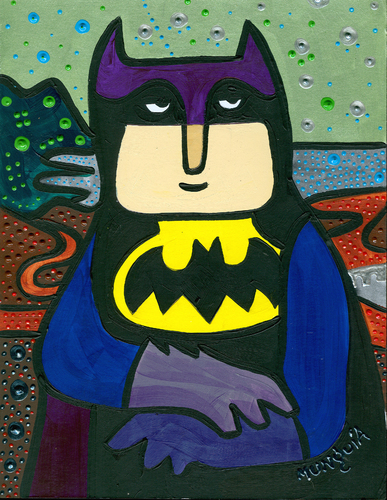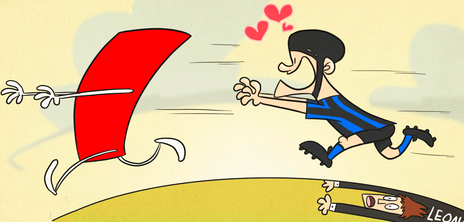Learn how this Angry Bird came into life.
Check out more of Ian Marsden´s videos on his youtube channel.
If you are an artist on toonpool.com and do your own “making of” videos, feel free to send us the link to your video so that we can feature it on our blog as well. Just write to [email protected].
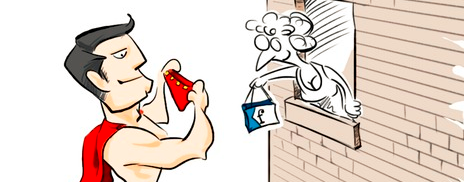
Every now and then I will stumble upon a cartoon I simply don’t get. At times I can stare at it for quite a long and still not get it. Some time ago I heard about Bill Bickel’s blog Comics I Don’t Understand. On CIDU he posts newspaper strips and webcomics that he, well, does not understand. Of course I had to ask for his expertise.
Since I didn’t bookmark the cryptic cartoons I had found in the past, I had to browse toonpool.com for some to illustrate this interview. Doing so I noticed two important differences I had to take in account: 1) We have a lot more illustrations and experimental cartoons, that aren’t meant to have a distinct meaning or gag in the first place 2) Several toonpool.com artists may post cartoons that are meant for an audience from their own culture. So.. the images I chose are cartoons I think I could be getting, i.e. cartoons that seem “international” and also look as if they have a simple meaning or punchline.
Bill, can you tell a bit about the history of the CIDU blog?
 I had — and still have — a friend named B. Joni who lives across the country. We wrote to one another frequently, and in years past we’d sometimes mail one another comic strips we didn’t understand. By 1994 we both had computers, and comics strips were starting to come online, so we were able to e-mail one another the comics. Brave New World!
I had — and still have — a friend named B. Joni who lives across the country. We wrote to one another frequently, and in years past we’d sometimes mail one another comic strips we didn’t understand. By 1994 we both had computers, and comics strips were starting to come online, so we were able to e-mail one another the comics. Brave New World!
But then she has to switch Internet Service Providers and could no longer receive e-mail attachments. I was already running a couple of web sites, and it occurred to me that if she couldn’t receive comics in the mail, I could start up an ad hoc web site just for the purpose of showing her the comics.
How did this become a public website?
Somewhere along the line, she passed along the address to some friends, who gave it to other friends, and at the same time I mentioned what I was doing to a kinsman and he passed along the address, and before long I was getting e-mail and comics from complete strangers.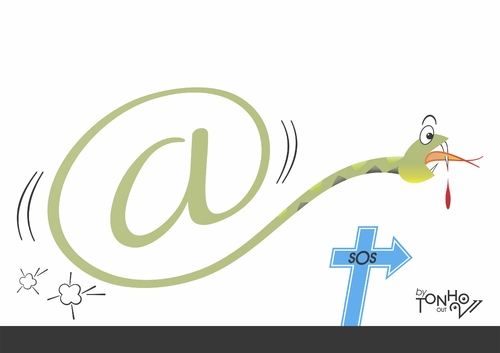
Then David Farley, whose “Doctor Fun” strip appeared frequently on CIDU, gave me a plug. Soon afterward the site was mentioned in the New York Times, and then in Entertainment Weekly’s “Must List” page – the same place my brother’s book Creepiosity got listed 14 years later, oddly enough.
Did you have any kind of cartoon/comic background before you started the page?
No background at all other than having read the comics since I was three or four. I can’t draw for shit. I did draw a comic once, though: to avoid failing a high school art class, I created a comic book – all of whose characters were constellations, so all I had to draw were combinations of white dots on black paper.
What, in your opinion, is the main cause for cryptic comics?
I’m not sure there’s a “main” cause, but here’s a partial list:
There are several instances of “This made sense to me when I thought of it at 3AM”. Then, there are gags based on regional knowledge the writer believes is universal. Or gags based on technical knowledge the writer believes is universal.
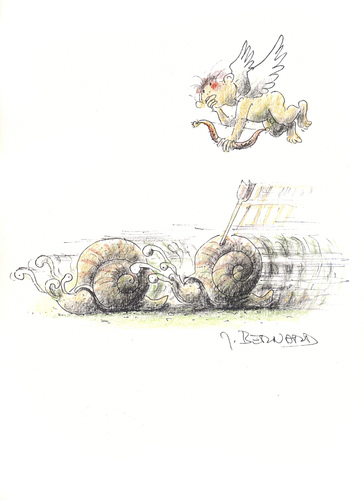 There are also those moments when a comic actually isn’t cryptic at all: it’s just plain not funny and I was looking for something that wasn’t there
There are also those moments when a comic actually isn’t cryptic at all: it’s just plain not funny and I was looking for something that wasn’t there
Sometimes the writer wanted to challenge his readers. Or he was being intentionally obscure to show off how clever he is. Then there are writers who are actually trying to get on CIDU.
And there are f***ing cats.
Wait.. how are cats a main cause of cryptic comics?
People have remarked – quite frequently and not without justification – that I simply don’t get any comics that involve cats.
In your FAQ you tell the original artists not to send in explanations. Is that something that actually does happen?
It did happen at first, before I added this to the FAQ. Still happens on occasion now, but invariably one of the regulars chastises the writer/artist before I ever see the comment. Self-policing communities; gotta love ‘em.
Dave Farley complains bitterly about this rule in his own FAQ, but it’s all in jest. The CIDU community misses Doctor Fun terribly.
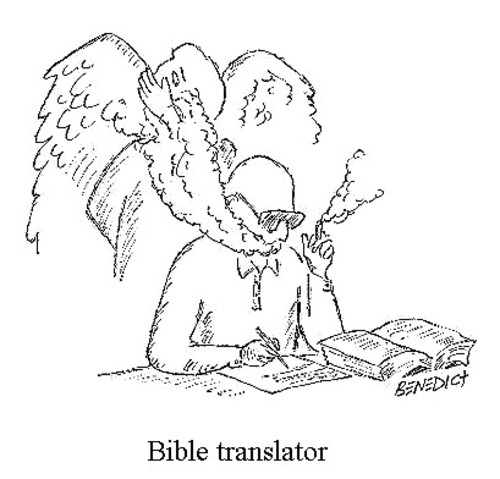 Have you ever had cartoons explained to you and then actually thought they were funny?
Have you ever had cartoons explained to you and then actually thought they were funny?
Of course.
You also post cartoons that are actually funny in addition to the ones you don’t understand. Why?
Out of respect for cartoonists. If I’m going to give them a hard time when they’re unclear, the least I can do is honor them when they really nail one. In the end, I’m a fan: I’d much rather appreciate a comic than be confused by one.
You have been collecting cartoons and reading other people’s attempts at explaining them for quite a while now. Has this changed your own perspective on cartoons in any way?
I don’t know, not really. I have gotten better at understanding how comics writers’ minds work. And I know a lot more than I used to about cats.
So, how DO comic writers’ minds work?
Like clockwork oranges.
Thanks for your time!
Title illustration: “Superman is Shopping” by Zenchip
]]>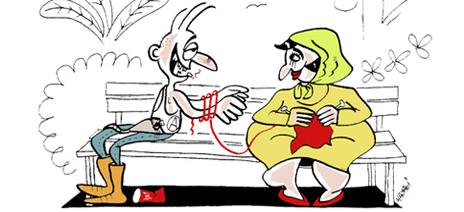
Hayati Boyacıoğlu is a Turkish-German cartoonist. His cartoons frequently deal with issues of integration and cultural relations.
Hayati, in the past weeks you posted several cartoons showing couples – most of them very unlikely ones. Where did that come from?
![]() You will see couples anywhere you go – on the subway, at a doctor’s office.. That’s when I start wondering what they do, what they tell each other, how they found each other, why him, why her… There’s hardly any subject more rewarding for a cartoonist than relationships.
You will see couples anywhere you go – on the subway, at a doctor’s office.. That’s when I start wondering what they do, what they tell each other, how they found each other, why him, why her… There’s hardly any subject more rewarding for a cartoonist than relationships.
Was there any particular couple that started the whole thing?
Yes. Back in 1995 I published a book that had a couple on the cover page – a punk and a Turkish woman with a headscarf. I saw those two sitting on a bench at Moritzplatz. In a city like Berlin these kinds of things are actually quite frequent.
You make up names for all of your couples…
Yes, but I only started doing this recently. It adds a certain warmth to a cartoon. I also want to add a common element to my couple drawings: it’s meant to show that we are all human beings, even though some people have a hard time accepting that.
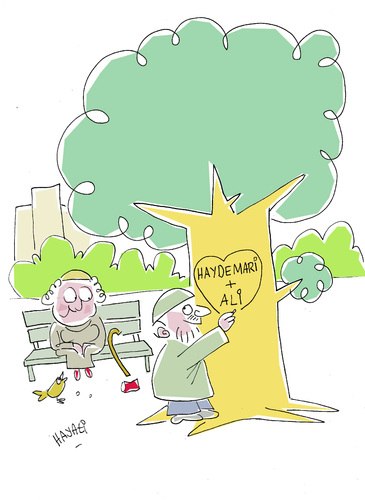 For example, I did this cartoon about “Heidemarie and Ali”. In that one Ali cuts both their names into a tree. These kinds of things just have to happen if you take into account that the first Turkish migrants came to Germany in 1960. It’s well possible that a Turkish man who arrived back then fell in love with a German. But in everyday life you see these things way too rarely.
For example, I did this cartoon about “Heidemarie and Ali”. In that one Ali cuts both their names into a tree. These kinds of things just have to happen if you take into account that the first Turkish migrants came to Germany in 1960. It’s well possible that a Turkish man who arrived back then fell in love with a German. But in everyday life you see these things way too rarely.
You were born in Istanbul and your wife is from Bremerhaven. Does you own experience influence your couple cartoons in any way?
Sure. We have known each other since 1978, when she was 14 and I was 17. I asked her to teach me German… She still does.
You also do political cartoons, say, about famine in Somalia..
There is a kind of scheme behind that. I will draw a number of “bourgeois feelgood cartoons” and then I will do one about starving Somalian children.
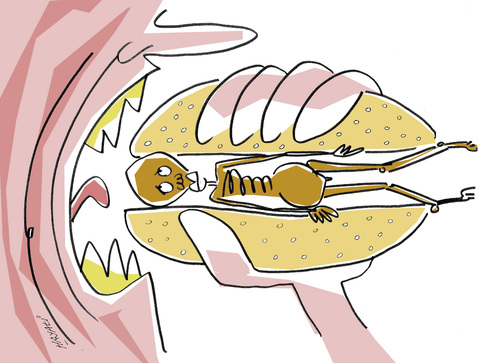 Do you draw it in that order or do you keep back the grisly ones to use them in the proper moment?
Do you draw it in that order or do you keep back the grisly ones to use them in the proper moment?
Sometimes I think about trying to control this.. but there’s no real need to. Life does that by itself. I will draw something about couples switching clothes and all of a sudden my routine is interrupted by a sinking ship with 20 refugees aboard and other people doing nothing. You just have to draw something about that.
Is there any agenda behind your cartoons?
Dario Fo once said that if you want to make people understand something you have to make them laugh. Because that’s when their brains will open up and you can add knowledge.
The problem with toonpool.com is that the audience is composed of artists, of satirists. There’s no need to teach each other. On Facebook, for example, I will get very different reactions to my cartoons.
Several of your political cartoons deal with Turkish issues, for example with the recent elections. Can you tell a bit about Turkish cartoons in general?
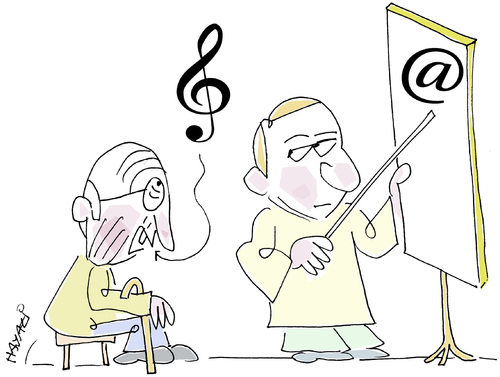 In Turkey, the newspapers’ headquarters are mostly based in Istanbul. Except for about four pages of the international issues, everything’s produced there.
In Turkey, the newspapers’ headquarters are mostly based in Istanbul. Except for about four pages of the international issues, everything’s produced there.
So, those international issues will hardly produce their own editorial cartoons. Perhaps because it’s hard to control editorial cartoons. In effect, most editorial cartoons deal with Istanbul issues and hardly ever with things happening anywhere else.
Are there any differences to German cartoons when it comes to humor?
Yes. There are basically two types. The first one does not really exist in Germany. It’s satirical magazines that are very cheap. Examples would be Leman or the now-defunct Gırgır.
German Titanic or Eulenspiegel cost 4 Euros each and, if you want to understand them you have to be well-read, know a thing or two about satire, etc. It’s not for everyone.
The Turkish magazines cost something like 25 cents and they are not too “high-brow”. Satire should be folksy and accessible for everyone – populist in a good way. I am trying to keep things simple, even though it doesn’t always work. Maybe that’s a point where I’m influenced by Germany.
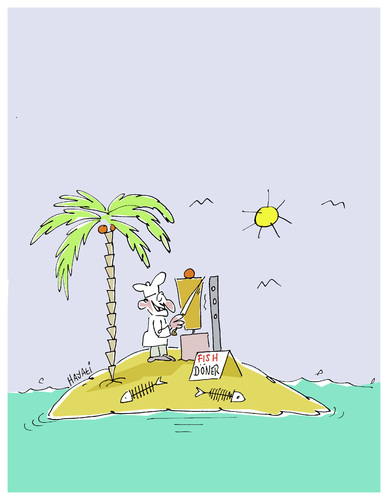 Isn’t there a danger that populist cartoons can very quickly turn to propaganda?
Isn’t there a danger that populist cartoons can very quickly turn to propaganda?
I don’t think so. Readers would notice this very quickly. And they will punish magazines by simply not buying them the following week.
How about the second type of cartoons?
Those are more artistic and don’t use captions. That’s one thing that sometimes poses problems for cartoonists from Yugoslavia, Romania, Bulgaria, and the like. Germans always use captions. Even on toonpool.com you need to fill in a title but, you know, the drawings are supposed to speak for themselves.
Where is this type usually published?
Artists will publish books or display them at exhibitions. There were a couple of more sophisticated satire magazines, but those never really worked.
Are you still in contact with cartoonists from Turkey?
Yes, I am. Thanks to toonpool.com, among others. I started drawing back in school, when Gırgır was still around [editor's note: Gırgır was originally published between 1972 and 1989].
I met a lot of like-minded people then. Some of them – like Erdogan Karayel - I met again in Germany. Others I found online. And, of course, I met a lot of new people.
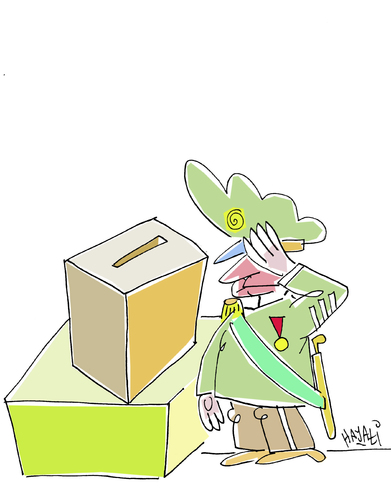 What are the main differences in opinion between “exiles” and artists back in Turkey?
What are the main differences in opinion between “exiles” and artists back in Turkey?
It always depends on how long you have been abroad. If you left only two or three years ago you can live here as you would have back in Turkey. You don’t really speak the language and you can stay at home and watch Turkish television. If you have been here for 20 or 30 years, though, if you keep your eyes open, you will change.
Which of your own attitudes, would you say, have changed?
I see some things differently. Some things that would be taboo over there, I don’t really mind anymore. When the Turkish military’s chiefs of staff resigned, mine was one of very few cartoons on this topic.. and it applauded the fact that they gave in to the power of the people. I hardly got any reactions on that one from Turkey.
Thanks for your time!
]]>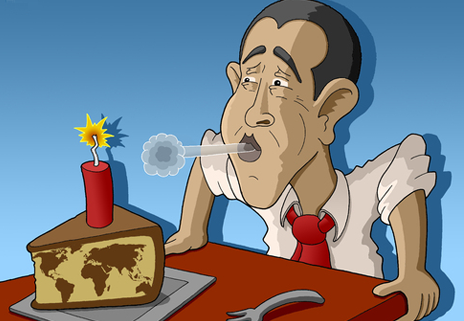
Barack Obama turned fifty on August 4. I guess the most common reaction to this piece of information is something like “Well.. good for him.” Or that’s what I was thinking, anyway. Still, it made me look up the Obama cartoons on toonpool.com (full list here). While doing so I noticed, that Mr. Obama rose to global fame about the same time that our site went online and has, in a way, accompanied us ever since
The first Obama cartoon was posted on January 9, 2008, not quite two months after toonpool.com was opened to the public. I have to admit that I’m not really sure about this particular cartoon’s meaning. Still, browsing through over 1700 Obama cartoons brings up a few memories and gives some insight into the way in which editorial cartoons and caricatures develop. If you would like to take a look into three years of political cartoons, here’s a rough timeline. [Unfortunately, the links in the titles are not permanent - things will change as soon as new Obama cartoons are added, but everything should be fine for couple of days]
Phase One : Democratic Primaries (~Januar-June 2008) [Wikipedia]
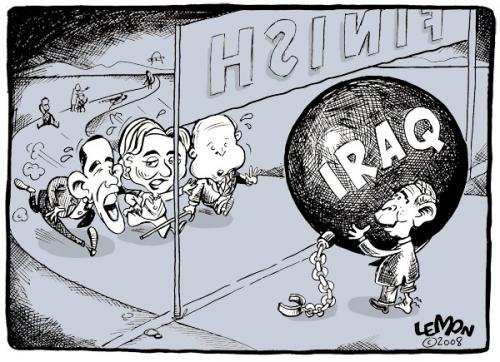 A lot of fierce battles between Obama and Clinton here. I really liked the Monty Python cartoon. Some apparently thought that McCain would profit from this.
A lot of fierce battles between Obama and Clinton here. I really liked the Monty Python cartoon. Some apparently thought that McCain would profit from this.
Phase Two : Obama VS McCain (~June-October 2008) [Wikipedia]
A lot of cartoons about everyone idolizing Obama here. This was also the time when he traveled to Berlin. And the time Sarah Palin showed up. On a sidenote: I remembered people talking about Obama walking on water.. but John McCain?!
Phase Three: Winning the Elections (November 2008) [Wikipedia]
Boy, were cartoonists enthusiastic about this. By January, a couple of people began to get tired of it, though.
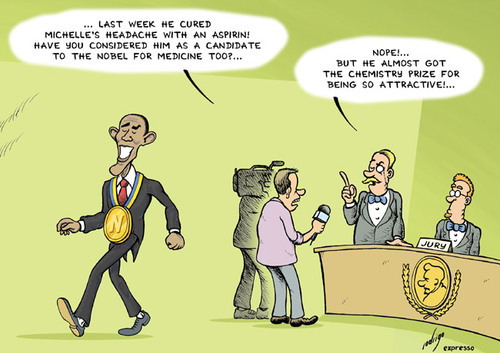 Phase Four: Obamacare (~August 2009- March 2010) [Wikipedia]
Phase Four: Obamacare (~August 2009- March 2010) [Wikipedia]
We have cartoons about its unsuspected difficulties, its cost, and – of course – about “death panels” (in case you forgot about those: more Wikipedia).
Phase Five: The Nobel Peace Prize (October – December 2009) [Wikipedia]
Phase Six: Nuclear Disarmament (April 2010) [Wikipedia]
There weren’t too many bad things people had to say about New START.
Phase Seven: The BP Spill (April-July 2010) [Wikipedia]
The “walking-on-water” thing was used a couple of times here. By the way.. does anyone know what things are like on the Gulf Coast?
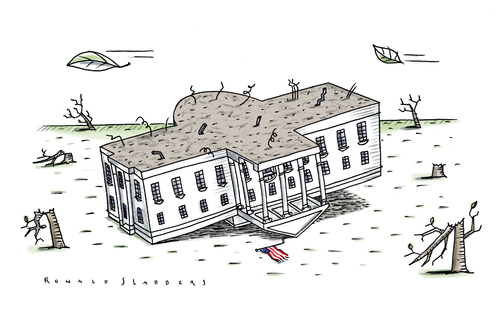 Phase Eight: Midterm Elections (November 2010) [Wikipedia]
Phase Eight: Midterm Elections (November 2010) [Wikipedia]
People who hadn’t heard about the Tea Party movement definitely did after November 2.
Phase Nine: Osama Bin Laden (May 2011) [Wikipedia]
If we have learned one thing from this, it’s that “Obama” sounds almost like “Osama”.
Phase Ten: The Debt Ceiling (~July-August 2010) [Wikipedia]
It was a wild ride, but we are safe now, right?
title image by Tjeerd Royaards
]]>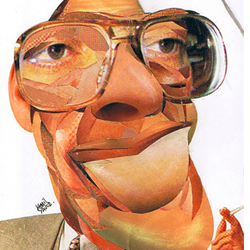 “Turkey Types” By Kamil Yavuz
“Turkey Types” By Kamil Yavuz
Kamil Yavuz from Istanbul has created a series of photomontage caricatures of Turkish politicians. I can’t really tell if they resemble their subjects because he didn’t provide any names and because I am far from familiar with Turkish politics.
Still, these portraits look amazing – the different textures and perspectives and the blown-up details work together perfectly. Please also note the animal familiars assigned to each politician (the guy to the left has bees) If anyone knows what this is about, please drop me a line.
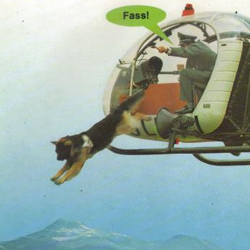 “Hundsgemein” by Andreas Prüstel
“Hundsgemein” by Andreas Prüstel
I have to admit that Mr. Prüstel is my favourite collage artist on toonpool.com. I guess it’s a mixture of his humor (by the way: the caption reads “Bite!”) and the retro feel of the collages.
The photos Prüstel uses are usually dated and slightly yellowed – if they are in color at all. Following the aesthetics of the Dada artists, these cartoons do not try to create an illusion of (sur-)reality but emphasize the incongruency of the elements pasted together. They would work great in a Terry-Gilliam-style animation.
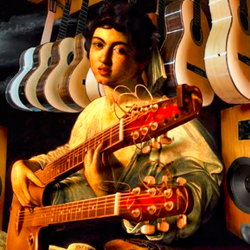 “Music Has No Age” by LuciD
“Music Has No Age” by LuciD
Romanian artist LuciD has a very different approach. The elements of his digital collages are blended together perfectly. Just look at the way he added the Ovation double-neck to Caravaggio’s Lute Player. I bet she is playing “Stairway to Heaven” and annoying the hell out of the store owner.
As with many of LuciD’s works, I wonder where he took the photos from. From my own experience I know that finding stock photos in the right angles takes a lot of time. So perhaps he takes the photos himself. Which may also take a lot of time.
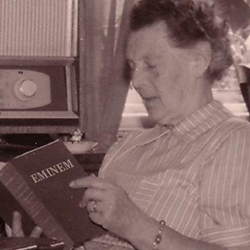 “Modern Times” by Prinzparadox
“Modern Times” by Prinzparadox
Creating this collage, on the other hand, didn’t take too long. The artist added a single word. But the minimalism makes the whole thing work. There is more here than the contrast between age groups and the questionable comedic value of totally radical senior citizens.
Please note that he book she is reading is not a book about Eminem (like, for example, as “The Way I Am” by Eminem). It’s Eminem, the book. Or the Book of Eminem. This is serious business.
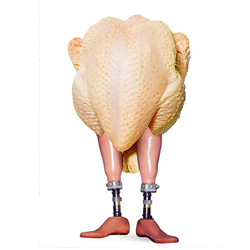 “Let’s Dance!” by Willem Rasing
“Let’s Dance!” by Willem Rasing
Not much to say here, really. It’s a chicken with prosthetic legs and it’s about to shake them. This has been proven to be funny as early as 1986.
It’s the grotesque jusxtaposition that does it. On one hand the plucked cadaver looks awkward and vulnerable, like naked people. People dancing in the nude are funny. Things dangling, and all. On the other hand it is a cadaver – dead meat (OK… poultry). And those legs.. they are meant for mutilated people. With stumps. Probably victims of land-mines, punji sticks or thalidomide. Being reminded of mortality and the fragility of our bodily integrity gives pretty much everyone the creeps.
PS: click here for a collection of photomontages , and here to see all cartoons marked as “collage” (some mislabeled images)
PPS: You can now follow me on Twitter
]]>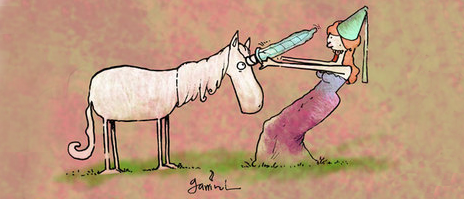
“Adult cartoons” is a topic that I have tried to avoid so far. There are mainly two things that I find problematic about the majority of sex-themed cartoons. The first one is that they are often more annoying than anything else. Basically they are the graphic equivalent of someone yelling “PENIS! See, I said PENIS!!!! And there is nothing you can do about it because this is the INTERNET!!! P-E-N-I-S!!!. The second problem is that so many of them perpetuate a sexist ideology that hasn’t changed much since the early days of Playboy.
Still, I thought it would be interesting to learn more about the motivation and thoughts of “adult” cartoonists. Gustavo “Garrincha” Rodriguez is a Cuban cartoonist and illustrator who moved to North Miami Beach, Florida in 2005. I admire many of Garrincha’s works: his vectorized caricatures are inventive and immediately recognizable and his line drawings have have an almost Sempé-ish lightness to them. On the other hand he also does a series of cartoons aptly titled “Dickies”. Hence this interview:
![]() Gustavo, what’s the story behind your series of sex-themed cartoons?
Gustavo, what’s the story behind your series of sex-themed cartoons?
Sex is still taboo to many people. Well, not sex, but talking or joking about it. Which is, as we all know, stupid. And hypocrite. And wonderful to depict.
So yeah, I’m a bit provocative there. I didn’t have a space to publish any of that material back in Cuba. Coming to the States and starting a blog where I can publish whatever the hell I wanted was therapy, catharsis, a test and healthy creative exercise all in one.
Why couldn’t you have done the sex cartoons from Cuba?
I wouldn’t have been able to set up a blog in Cuba mainly because Internet connection is scarce and state-controlled. Even having a computer is a big deal there.
Most artists use computers as an extension of their work in government propaganda, or to talk about politically correct subjects in sports, culture, or technology. Because they want to or because they know they are being watched.
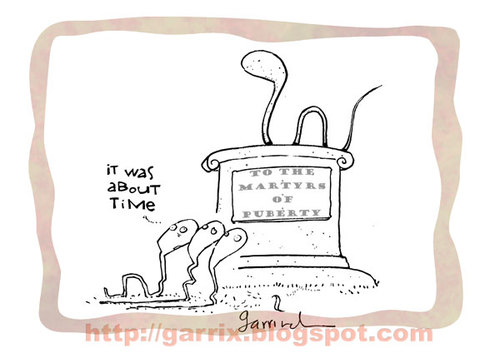 There is that thing with the control and censorship government bureaucrats take so seriously. They keep reminding everybody in earshot that the Cuban Revolution is a superior project. So revolutionary morality – whatever that means – is something they try to keep an eye on.. Soft erotic content is OK sometimes in one of the two humor publications nationally distributed, but drawing penises is a no no, to put it grossly.
There is that thing with the control and censorship government bureaucrats take so seriously. They keep reminding everybody in earshot that the Cuban Revolution is a superior project. So revolutionary morality – whatever that means – is something they try to keep an eye on.. Soft erotic content is OK sometimes in one of the two humor publications nationally distributed, but drawing penises is a no no, to put it grossly.
I would have thought that Americans would be more touchy about all things sex-related..
Mainstream America is conservative and sometimes prude. But there are pockets or niches. The Internet definitely opens extra doors.
Having a personal blog and a website where I can publish everything is something I could have never dreamed of in Cuba. And so far I haven’t had anybody in the States telling me to shut it down because the content is indecent or politically incorrect.
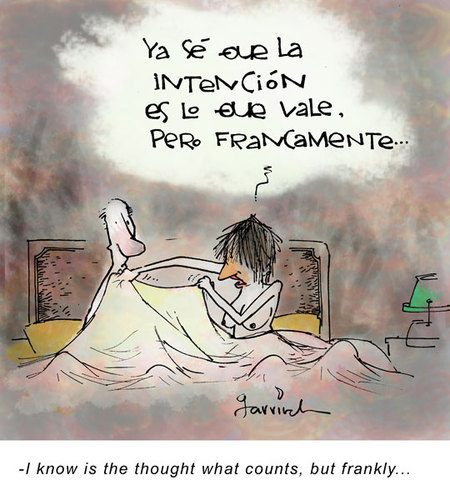 How is the ratio of sex cartoons to family-friendly ones in your current work?
How is the ratio of sex cartoons to family-friendly ones in your current work?
I would say is a quarter of what I draw, counting comic strips, illustrations, caricatures, editorial cartoons and gag cartoons. Maybe less.
It’s just that I find it relaxing being provocative and finding accomplices in the more familiar or intimate circuit of my reduced number of blog readers, Facebook friends or toonpool.com users. Although the latter two imply a number of readers not as small as I have imagined.
The majority of your sex-themed cartoons takes a males perspective with women and their genitals being demoted to objects of desire for the penile protagonists. Why such limitation?
Because that’s how pathetic we are.
Who is “we”?
Uh… Men as a group? Mankind in general?
I am pretty sure that – at least – one half of mankind would disagree. So, let’s stick with “men as a group”. Do you think that in the end, looking at yourself and other men, it all comes down to that?
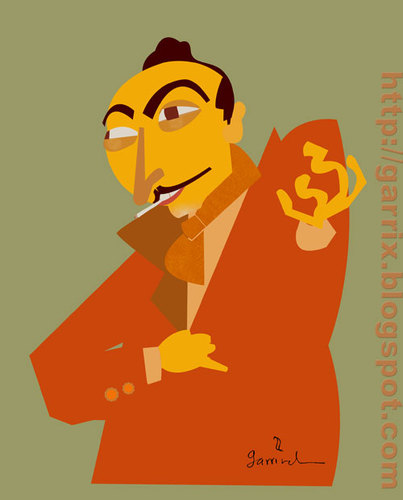 Oh, sure! I know for a fact that very few people would admit that they have something pathetic in their lives. Me, I try to stay honest. And self-deprecating helps, no doubt.
Oh, sure! I know for a fact that very few people would admit that they have something pathetic in their lives. Me, I try to stay honest. And self-deprecating helps, no doubt.
I don’t really believe my approach to sex in cartoons should be taken as an “in the end” judgment of any kind. That’s too serious of a stance. It’s like making Bob Dylan’s poetry a philosophy of life, a doctrine. I mean, come on! If my male readers laugh at themselves with my toons, fine! If they don’t, too bad for them.
Some of my cartoons focus on sex sometimes to remind people that indeed they are focused on sex but lots of them won’t admit it. I make that matter public, and I try to do it in a funny way.
Is there something inherently funny about sex and male genitals in particular?
It all depends on whose genitals are we talking about.
So, whose genitals are funny?
“Ha-ha-ha”-funny or “That’s weird!”-funny? Well, I guess Khadafi and Hugo Chavez think theirs are cute. Even each other’s.
Look, penises are cucumbers with an attitude. Women genitalia on the other hand, are very… How to put it? Have you seen Gerald Scarfe’s flowers in Pink Floyd’s The Wall? Scary, huh?
Women are too gorgeous to reduce them to a walking vagina or a dancing pair of boobs. I’m not satisfied at all with the vaginas I draw, I have to say. To sum up, penises are excellent characters to draw about the male brain.
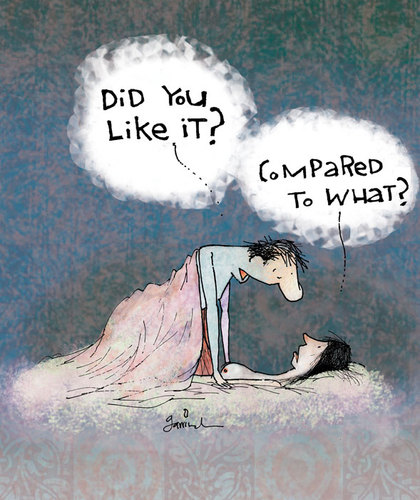 How do people react to your explicit cartoons? Is my question about limitation one that often comes up?
How do people react to your explicit cartoons? Is my question about limitation one that often comes up?
I can only tell from comments and emails, but it has been mostly a popular reception. Men and women alike seem to like ‘em.
How about other people’s adult cartoons? Do you enjoy those?
If you have sense of humor in treating sex as a theme, and if you have good drawing and conceptualizing skills, it means to me that you are a special person who chose to enjoy life.
The wit, the high quality of the drawings and the liberating feeling of mocking our sorry human nature are things not to be taken lightly. So yes, I do enjoy other artists’ cartoons about sex if their work is funny, well-drawn and communicates effectively. I think I should start a club.
Thanks for your time!
]]>
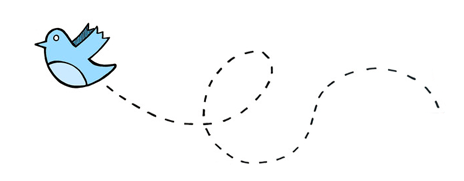
About a week ago we introduced a Twitter button to toonpool.com. You can now tweet cartoons by clicking on that little blue button located below the image.T his seemed like a good opportunity to take a closer look at cartoonists on Twitter.
There are about 2350 artists who post cartoons on toonpool.com. When we did some research for this article we found something like 50 Twitter accounts by toonpool members. Even if we missed another 100 this still shows that not too many cartoonists are using Twitter. When I asked some of the ones who do about how long they had been using the service, answers ranged between 1,5 years and six months. So, cartoonists aren’t exactly early adopters either. At times the fascination with the new technology gets old pretty fast. Back in 2009 German cartoonist Til Mette set up a Twitter account, tweeted three times between 3:37 and 4:10 and then was all like “Meh.”
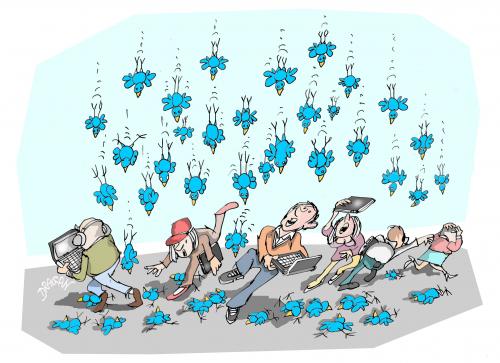
Looking at my timeline I have to admit that it is pretty easy to be all like “Meh.”. Even if you are following less than a hundred people there are a lot of new messages per hour. Content-wise, tweets by cartoonists oscillate between the banal ["It is urgent. Need bacon." (@ericHews)], the matter-of-factly ["Un Dragofante by Arghoost Toons. http://t.co/m7TkXRg" (@arghoost_toons)] and the cryptic ["http://bit.ly/mPlnkh #TimThomas#caricature #Bruins #bostonbruins #bruinscartoons #TimThomasMVP #TimThomasVez… (cont) http://deck.ly/~J8hbF" (@spicertoon)].
I asked Canadian artist Mike Spicer – author of the hashtag-heavy tweet above – about his motivation for using Twitter. “I think through the #FF, etc. one hopes to cast a wide net and build a solid following with the vastness,” he replied. “New-age word of mouth.” That’s how a lot of artists seem to use Twitter and, if they are any good, I am sure they will get the occasional new follower. And, yes, I think that such straightforward advertising tweets are boring and perhaps even counter-productive. Gustavo Rodriguez aka Garrincha describes the phenomenon as follows: “What you do on Twitter is showing at your doorstep with a bullhorn and shouting whatever the 140 characters and your brain allow at that moment.” No wonder that a lot of people stay away from that neighborhood.
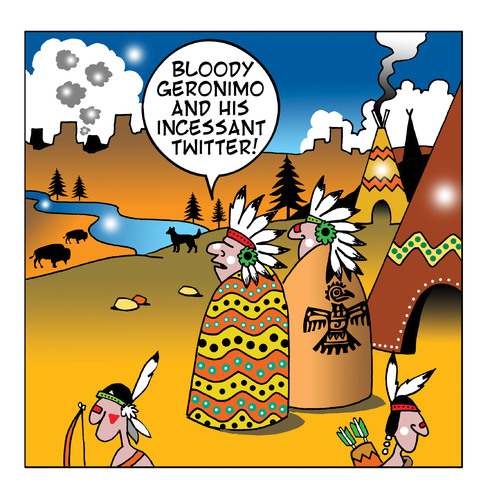 That is, however, not all there is to Twitter. Things get a lot more interesting when people start shouting back. In fact, as soon as there is some interaction it feels more like an overcrowded bar than like Garrincha’s shouty suburb. As Tjeerd Royards, cartoonist and editor of a digital cartoon magazine, points out, it is easier to reach out to people informally in a tweet than writing them an email or even a message on Facebook. This can allow for new interactions between artists and fans and colleagues – if tweets actually allow for comments and transcend being 140-character billboards, that is. One cartoonist that I think does a particularly good job is BECK . Mr. Beck not only shares slices of his life and interacts with followers but also turns tweets he likes into cartoons.
That is, however, not all there is to Twitter. Things get a lot more interesting when people start shouting back. In fact, as soon as there is some interaction it feels more like an overcrowded bar than like Garrincha’s shouty suburb. As Tjeerd Royards, cartoonist and editor of a digital cartoon magazine, points out, it is easier to reach out to people informally in a tweet than writing them an email or even a message on Facebook. This can allow for new interactions between artists and fans and colleagues – if tweets actually allow for comments and transcend being 140-character billboards, that is. One cartoonist that I think does a particularly good job is BECK . Mr. Beck not only shares slices of his life and interacts with followers but also turns tweets he likes into cartoons.
The question is: Are you willing to invest the amont of time and creativity it takes to run a varied Twitter account and – even more important – do you feel comfortable with constantly making your own thoughts and personality public? If you don’t, there are lots of other ways of promoting your cartoons on the Internet and missing out on one probably won’t hurt too much. If you do, you should go on there, make your art known and help to fight the “Meh.”
Paul Hellmich with additional research by Battlestar
PS: Here’s a collection of Twitter cartoons and, of course, you can (and maybe should) follow @toonpool
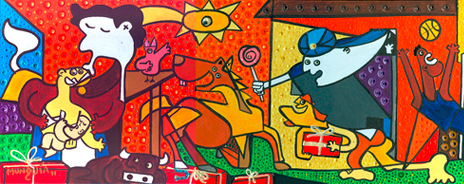
Francisco Munguía is based in San José, the capital of Costa Rica. He is a full-time cartoon artist doing newspaper cartoons, paintings, ceramics murals and even computer games. Francisco and his wife Debora live together with their two sons and 25 dogs.
My first interaction with Munguía took place about a year ago when I messed up his first name in an article about cartoon parodies of famous works of art. I have to admit that this still bugs me. Here is a proper interview:
![]() Francisco, you often quote well-known paintings in your cartoons. Can you tell a little bit about that?
Francisco, you often quote well-known paintings in your cartoons. Can you tell a little bit about that?
You’re right. Parodies of famous paintings make up for the greatest part of my “Calcamunguías” series. By now I must have done more than 200 of these reinterpretations. I prefer to caricature a work of art rather than politicians.
People from Guatemala, Holland, Korea, Ghana, or Spain easily recognize the Mona Lisa, or Munch’s Scream, but I think they hardly know the name of the president of my country. Chances that it will still be like this in 100 years are very high.
So, people like the parodies?
Yes, I started this series in 2008 and it became very popular. I even managed to organize a traveling exhibition of several rooms. Humor and parody are a great way to bring universal art to young audiences. In each exhibit my paintings are accompanied by a photo of the original painting, and the names of the piece and the artist. I also use the paintings to carry forward messages of animal welfare, ecology, and social interest…
While I love art, lots of paintings often seem boring to me – without humor and color. I’ll arrange that. My works are an upgrade, so to say.
What exactly do you mean by “boring”?
Over time, art has become more colorful and humorous, less realistic in form and more realistic in content, Michelangelo was gifted but his themes are limited by religious mythology. Rembrandt is a great artist but I do not like the many shadows in his paintings. Goya is extraordinary and very critical, but his works are void of color and the humor is very black.
I prefer the toonpool cartoons to Mona Lisa, but I enjoy Mona Lisa much more than CNN news. The best example I have is Guernica, one of my favorite paintings – a large painting, very critical, but all the characters suffer. It’s gray, it’s sad, and it is a cruel reflection of war. My version is happy and optimistic. The family is celebrating the birth of the child, they live in peace surrounded by animals. It is full of color, like an exorcism of the original.
Still, there must be something you like about the original paintings.. right?
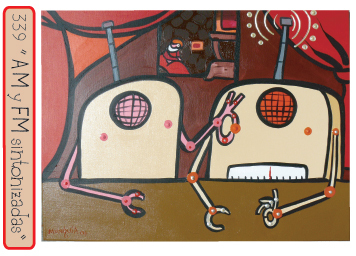 You can learn many things from works of art from the past – composition, color, history, allegory, symbolism. But I prefer the more recent artists: Van Gogh, Picasso, Duchamp, Magritte. The latter being very colorful, very symbolic, and very close to cartoons.
You can learn many things from works of art from the past – composition, color, history, allegory, symbolism. But I prefer the more recent artists: Van Gogh, Picasso, Duchamp, Magritte. The latter being very colorful, very symbolic, and very close to cartoons.
How did you decide on the color scheme you are using?
Costa Rica is a very colorful place. This has definitely influenced my art. I use a preset color palette when working on the computer. In my paintings I am more free. I use intense and plain colors, I will create texture by overlapping spots, dots and drops of pigment. I hardly ever use shadows – I am all for day-life, I love the light. Coloring is the most spontaneous part of my work, it is like a game.
Your cartoons look as if they are done very quickly. Is that true?
I am a fast artist. Coming up with ideas may take some time but I have so many in line that I have more ideas than time to realize them.
Some of my drawings take 20 minutes from the white sheet to adding color on the computer. I am even faster when I do several pieces at once. I can paint up to three pictures at once and finish them in one day.
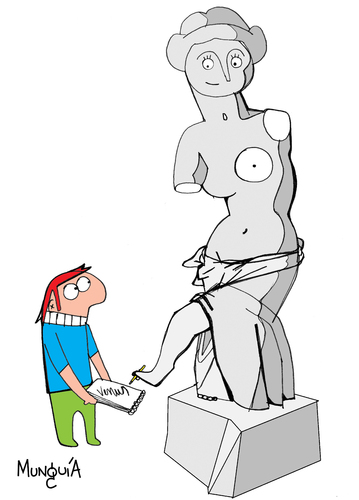 I paint murals of 30 square meters in four hours, but my ceramic pieces, for example, take me a couple of weeks. My largest mural took me two weeks with the help of one assistant. But there was also one that lasted two months. It was a pedestrian bridge that was painted underneath, inside, outside and everywhere. I needed cranes, extensions and several assistants for that one.
I paint murals of 30 square meters in four hours, but my ceramic pieces, for example, take me a couple of weeks. My largest mural took me two weeks with the help of one assistant. But there was also one that lasted two months. It was a pedestrian bridge that was painted underneath, inside, outside and everywhere. I needed cranes, extensions and several assistants for that one.
What, exactly, is the jobs of the assistants?
For my murals I cooperate with the community where I paint. Neighbors join the production as volunteers. Often they will ad the colors to the drawings – sometimes even little kids will paint a small piece. This way they become part of the art and the neighborhood improvement.
Other things assistants will do is to clean my brushes, put the paint into little containers for the use of volunteers. I am responsible for all drawings, for the coordination, I will fix errors made by volunteers and will finally add all the lines that define the painting.
Which do you like better – the murals or the small formats?
It’s hard to choose. The mural brings me closer to communities, but in the smaller formats I can do at home even if it is raining. The decision for “micro” or “macro” depends on the needs of the moment, and my time. Also the murals need sponsors, the small formats don´t.
Thanks for your time!
]]>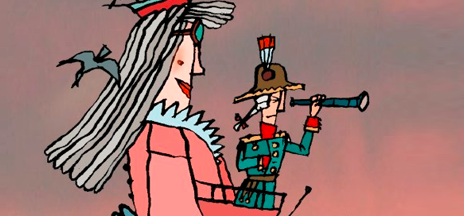
Schwoe… – bürgerlich Matthias Schwoerer – lebt und arbeitet im südbadischen Badenweiler, gut zehn Kilometer von der französischen Grenze entfernt.
![]() Matthias, du hast unter anderem als Käselieferant, Gymnasiallehrer, Regieassistent und Schauspieler gearbeitet bevor du Cartoonist und Illustrator wurdest. Warum so unterschiedliche Jobs?
Matthias, du hast unter anderem als Käselieferant, Gymnasiallehrer, Regieassistent und Schauspieler gearbeitet bevor du Cartoonist und Illustrator wurdest. Warum so unterschiedliche Jobs?
Das ist so eine typische Formulierung aus vielen Künstlerbiografien. Sie soll zeigen, wie schließlich die göttliche Fügung den Künstler mit sicherem Griff aus der Masse von Käsefahrern, Gymnasiallehrern usw. herausgepickt und in sein Atelier gesetzt hat, in dem er dann die unsterblichen Meisterwerke machen konnte, die z.B. auf Toonpool zu sehen sind.
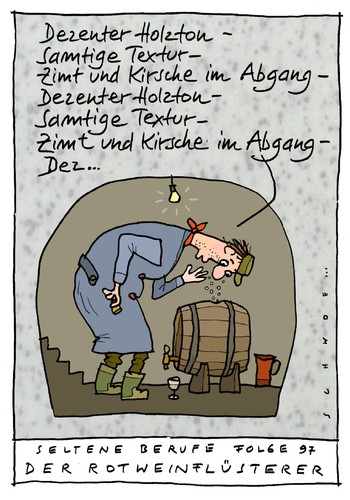 Wenn man’s banaler betrachtet, kann man auch sagen: Ich hab mir das Künstlersein erst mal nicht zugetraut und bin Beamter geworden. Ich war sehr gerne Lehrer, habe aber doch gedacht: ‘Das kann es doch nicht gewesen sein!’ Der nächste Schritt, Theater, war dann wenigstens noch eine Institution.
Wenn man’s banaler betrachtet, kann man auch sagen: Ich hab mir das Künstlersein erst mal nicht zugetraut und bin Beamter geworden. Ich war sehr gerne Lehrer, habe aber doch gedacht: ‘Das kann es doch nicht gewesen sein!’ Der nächste Schritt, Theater, war dann wenigstens noch eine Institution.
Wie kam es, dass du Schauspieler geworden bist ?
Theater war für mich schon von Kindheit an was Faszinierendes, erst Kasperle-Theater, dann Schultheater. Als ich dann mutig genug war, selbst ans Profitheater zu gehen, war ich erst Bühnenbildner, wollte dann aber in die Regie. Da fängt man als Assistent an und hat an den meisten Theatern auch Spielverpflichtung. Schauspieler war ich also nur in kleinen Nebenrollen.
Würdest du sagen, dass die Schauspielerei einen Einfluss auf deine Arbeit als Cartoonist hat?
Das Theater wurde aus einem Nebeneffekt heraus wichtig für mich als Cartoonist: Ich habe dort viele Schauspieler kennengelernt, die einfach großen Mut in der Selbstverwirklichung hatten, die aus Verträgen ausgebrochen sind, weil es ihnen nicht mehr gepasst hat, die neue Projekte mit völlig unsicherer Finanzierung in Angriff genommen haben und so weiter.
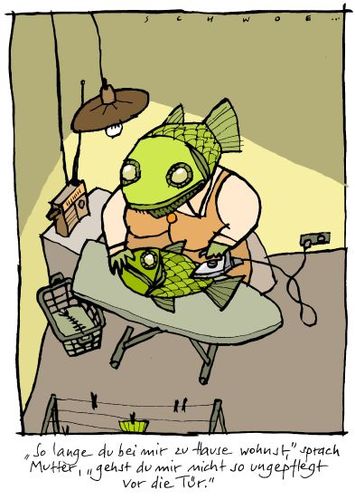 Irgendwann habe ich mir dann gesagt: ‘Warum bist du eigentlich so feige und versuchst nicht mal das wirklich professionell zu machen, was du immer schon kannst, nämlich zeichnen?’ Das lag mir dann auch sehr viel mehr, als die fanatische, intrigen-verseuchte Teamworkerei mit lauter Egomanen am Theater.
Irgendwann habe ich mir dann gesagt: ‘Warum bist du eigentlich so feige und versuchst nicht mal das wirklich professionell zu machen, was du immer schon kannst, nämlich zeichnen?’ Das lag mir dann auch sehr viel mehr, als die fanatische, intrigen-verseuchte Teamworkerei mit lauter Egomanen am Theater.
Dann, am Zeichentisch, hatte ich allerdings erst einmal die völlig verkehrte Vorstellung, man müsse nur zeichnen können, um es als Cartoonist zu was zu bringen. Man muss aber vor allem die Selbstvermarktung können und lieben. Und das ist leider bis heute nicht mein Ding.
Woran genau hast du gemerkt, dass Selbstvermarktung ein wesentlicher Teil des Berufs Cartoonist ist?
Ich lege ziemlich strenge Maßstäbe an meine eigenen Cartoons hinsichtlich Darstellung und Pointe an und sehe dann, was für ein Mist statt meiner Cartoons abgedruckt wird. Das kann dann ja nur an meinem Marketing liegen. Zugegeben: Ich
bin da echt faul, unfähig, inkonsequent, arrogant, selbstmitleidig, weltfremd und unprofessionell – habe ich etwas vergessen? Im Grunde würde ich mir einen Agenten wünschen, der vor allem. mich im Auge hat und sich nicht zu schade ist, mich immer und immer wieder in den Arsch zu treten.
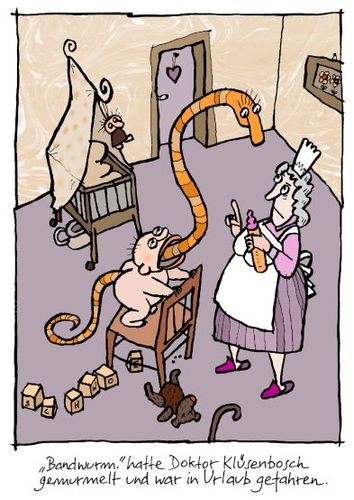 Ich würde jedem, der was von Selbstvermarktung versteht, zuraten, Cartoonist zu werden. So schlecht kann niemand zeichnen, als dass er mit einem entsprechend programmierten Ego nicht doch veröffentlicht würde. Allerdings bringt man’s mit so einem Ego als Chefarzt oder bei der Bank oder in der Politik eventuell zu mehr Kohle. Und ich hab einen Konkurrenten weniger.
Ich würde jedem, der was von Selbstvermarktung versteht, zuraten, Cartoonist zu werden. So schlecht kann niemand zeichnen, als dass er mit einem entsprechend programmierten Ego nicht doch veröffentlicht würde. Allerdings bringt man’s mit so einem Ego als Chefarzt oder bei der Bank oder in der Politik eventuell zu mehr Kohle. Und ich hab einen Konkurrenten weniger.
Deine Cartoons haben oft eine seltsame Perspektive, von der zumindest ich ein bisschen Nackenprobleme bekomme – wie wenn ich Claus Kleber angucke. Wie ist diese Perspektive entstanden?
Claus Kleber? Ist der so winzig?
Nee, aber er hat so eine seltsame Kombination aus einem asymmetrischen Gesicht und einer schiefen Haltung, dass ich es immer ein bisschen anstrengend finde, ihn anzugucken.
Ich finde jedenfalls, dass man auf meine Figuren und Räume immer eher von oben runter guckt. Das erleichtert mir die räumliche Staffelung der Gestalten. Außerdem mag ich es, wenn man bei den Köpfen möglichst beide Augen sieht. Das wirkt bei der Draufsicht am natürlichsten, bringt aber sonst auch eine netten Picasso-Effekt.
Deinen Cartoon mit der kotzenden Titanic finde ich großartig aber auch sehr seltsam. Wie kam der denn denn zustande?
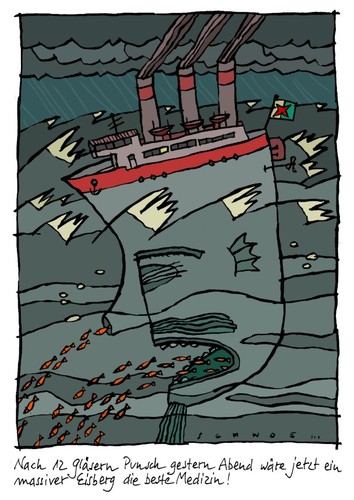 Meine Bilder entstehen meist ziemlich vollständig im Kopf. Bei der Titanic fand ich interessant, den arglosen Kreuzfahrern mal zu zeigen, was unter der Wasserlinie wirklich vor sich geht. Kunst sollte ja immer zeigen, was dem normalen Auge verborgen ist.
Meine Bilder entstehen meist ziemlich vollständig im Kopf. Bei der Titanic fand ich interessant, den arglosen Kreuzfahrern mal zu zeigen, was unter der Wasserlinie wirklich vor sich geht. Kunst sollte ja immer zeigen, was dem normalen Auge verborgen ist.
Dass das Schiff selbst unter dem Seegang leidet, kam erst beim Zeichnen dazu. Aber auch viele Seeleute werden immer wieder seekrank, das Ausüben der immer gleichen Tätigkeit bringt einen eben nicht unbedingt weiter. Das gilt auch für Cartoonisten.
Ist es nicht ein bisschen widersprüchlich wenn du einerseits schreibst, dass deine Bilder vollständig im Kopf entstehen, die Leiden des Schiffes aber erst beim Zeichnen dazu kamen. Ist der Cartoon jetzt eine Ausnahme?
Ja, das ist eher die Ausnahme. Von anderen Zeichnern hört man immer mal: Ich fang einfach an zu kritzeln, und dann wird schon was draus. Das muss nicht schlecht sein, funktioniert bei mir aber nicht
Ich muss die Grundidee im Kopf entwickeln, dann kann natürlich beim Zeichnen noch der eine oder andere Schnörkel dazu wachsen. Die Texte mache ich oft erst später.
Stammen deine schwarz-weißen Cartoons und die farbigen aus unterschiedlichen Schaffensperioden oder hast du gewissermaßen zwei unterschiedliche Zeichenstile?
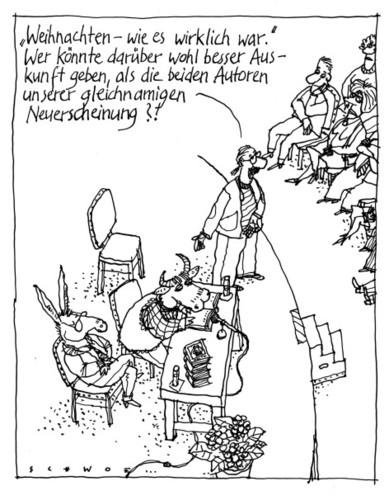 Zwei Stile? Das wäre ja nett! Vor allem viel besser zum Vermarkten! Inzwischen habe ich – glaube ich – fünf bis sechs Stile.
Zwei Stile? Das wäre ja nett! Vor allem viel besser zum Vermarkten! Inzwischen habe ich – glaube ich – fünf bis sechs Stile.
Erstens wären da Cartoons, die ich mit Tuschefeder zeichne, mit und ohne Aquarellfarbe. Dann benutze ich manchmal einen schmalen Filzer für die Konturzeichnung, und mache die Farbfüllung mit einem Bildbearbeitungsprogramm. In einer dritten Kategorie benutze ich einen Tuschepinsel für Konturzeichnung und Bildbearbeitung für die Farbfüllung. Bei diesen Cartoons sind die Themen immer etwas komplex und der Text ist nie im Bild sondern nur in der Unterschrift. Dann gibt es Cartoons, die ähnlich aufgebaut sind, aber rein schwarz-weiß. Ich habe für die Bilder aus den letzten beiden Kategorien die Schublade “Ebene 2″, weil sie halt ein bissel “abgehoben” sind.
Eine fünfte Variante zeichne ich mit Tuschepinsel und male sie mit dem Computer aus. Das sind aber typischere Cartoons, wo der Text oft im Bild steht. Eine Sonderform sind die Blätter, die ich “Cartoon-Stories” . Die tauchen immer mal wieder im Schweizer “Nebelspalter” auf und sind eine Art cartoonistischer Essay.
Ich finde es interessant, dass du deine Cartoons selbst in klar umgrenzte Kategorien steckst – nach Witztyp, Materialien & Aufteilung. Wie beeinflusst das deine Arbeit?
Ein großer Teil meiner Arbeit sind nicht Cartoons, sondern Illustrationen oder illustrierende Cartoons, die vom Stil her zum Auftraggeber passen müssen. Wenn ich dann frei arbeite, nehme ich mir tatsächlich vor, dass ich jetzt mal Ideen für einen meiner Stile “gebären” will.
Wenn ich mir ein Thema vornehme, geht das auch ganz gut. Es gehört für mich zur Professionalität, dass ich auch unter Zeitdruck Ideen zu allen möglichen Vorgaben entwickeln kann, eben auch zu Vorgaben, die ich mir selbst gebe.
Danke, dass du dir die Zeit genommen hast!
]]>Cartoons are all about information. If you don’t know certain things, they won’t work. Admittedly, a lot of cartoons won’t work even though you might get the joke because they just aren’t funny. But let’s stick with the information part. On toonpool.com you can usually get along quite well if you know your pop culture and have some idea about recent news items from a cartoon’s country of origin (language barriers left aside, that is).
“Special interest” cartoons, on the other hand, demand knowledge held by comparably smaller groups of people. They offer a kind of in-crowd bonus (“Ha! There are only twenty people in the world who will get this joke. And I am one of them.”) and, perhaps more important, enable people to discuss parts of their lives that do not get covered in general public discourse. Special interest gags have been around a long time, both in oral culture (“What does it say on a blues singer’s tombstone?”) and in cartoons published in journals or fanzines.
Of course their numbers have increased greatly through the internet. There are webcomics for PhD students, History majors, and programmers. As well as many, many others. My choice of examples, however, apart from displaying my own geekiness points to a major bias in special interest cartoons and Internet culture in general: A lot of it is made by and meant for people with higher education. There aren’t too many cartoons about plumbing, although I am sure that there must be lots of inside jokes. Taking an optimistic view on the democratic potential of the internet, you could argue that this will change in the next couple of years. I definitely hope it will. Staring at esoteric cartoons is a great (although not necessarily successful) way of learning about society.
Sports cartoons are a bit of an exception to the bias I mentioned earlier. While I would still count them as special interest, they cater to a much wider range of people. Omar “Omomani” Momani is a 30-year-old cartoonist and animator from Jordan. He is an animation team leader at a company called Crazy Piranha Studios and draws football-themed cartoons for a website called goal.com. We talked about his own fandom, about how he became a football cartoonist and about players who simply look funny.
![]() Omar, since you do a lot of cartoons on football, I guess that you are a fan.. What’s your team?
Omar, since you do a lot of cartoons on football, I guess that you are a fan.. What’s your team?
Of course am a fan! I am a big fan of AC Milan. I support them since childhood, Milan is part of my life indeed.
What was it about Milan that made you – someone who grew up in a different country – a fan?
It was in 1989 and 1990 when I first noticed football. Milan was then the best team on the planet. So, as a child, I became obsessed with their magic. I liked the understanding between the lines – Baresi – Maldini, Rijkaard – Gullit – Van Basten.
What did you think about them this season? They won the Serie A but didn’t do too well in the Champion’s league…
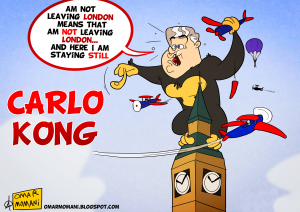 Honestly, I was not that happy. Milan just lacked the spirit. In the past Milan has had the same soul in its various eras – Sacchi Milan, Cappelo Milan, Ancelotti Milan. When you saw them play you knew it was Milan, I didn’t feel that this season. And, besides, I am sad about the departure of Pirlo. He was my favorite player in Milan.
Honestly, I was not that happy. Milan just lacked the spirit. In the past Milan has had the same soul in its various eras – Sacchi Milan, Cappelo Milan, Ancelotti Milan. When you saw them play you knew it was Milan, I didn’t feel that this season. And, besides, I am sad about the departure of Pirlo. He was my favorite player in Milan.
How many games do you watch in a week?
Well, it’s impossible to watch all the games in the world. I focus on the major European leagues. If I can make it, I will watch the most important matches of the week. Usually three games a week, but I also follow all the summaries in these leagues as well as the news.
How did you end up drawing football cartoons?
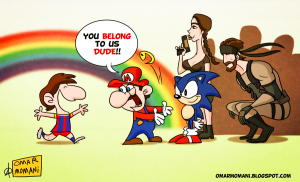 This came up during the last World Cup. My friends asked me to start drawing cartoons in general. I found that football was a good subject for me as an animator. Football gives you all the actions and ideas you need. Well.. then I contacted Goal.com. They liked the idea and signed me up to be their cartoonist.
This came up during the last World Cup. My friends asked me to start drawing cartoons in general. I found that football was a good subject for me as an animator. Football gives you all the actions and ideas you need. Well.. then I contacted Goal.com. They liked the idea and signed me up to be their cartoonist.
Do you follow football cartoons by other people?
I have been searching for other colleagues but I didn’t find many. Maybe because I am new at this. I like Caye‘s sports cartoons but they are so biased with Barcelona. I try to be neutral when drawing a cartoon.
Which football personality is most fun to draw and/or to use for a cartoon?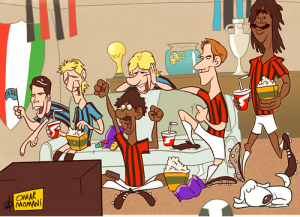
I love classic playerslike Valderrama and Gullit, they are hip and cool. As for modern football there are Messi, Gatusso, Puyol and Rooney.
What is it that makes them suited for cartoons?
Their funny looks. When you hear Puyol’s name you always remember his hair. Its like he is the “hairy man”. Gullit is the same but with a funny mustache. Other players look much less unique. Xavi for instance. From a cartoonist’s point of view, of course.
Are you going to draw cartoons about the Women’s World Cup?
If and idea pops up, of course i will!
Thanks for your time!
]]>
